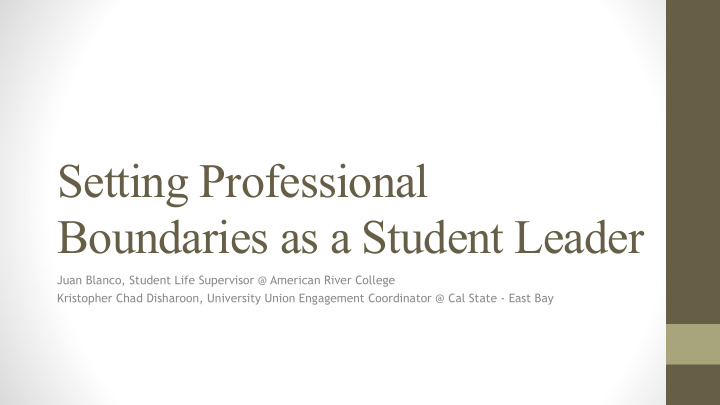



Setting Professional Boundaries as a Student Leader Juan Blanco, Student Life Supervisor @ American River College Kristopher Chad Disharoon, University Union Engagement Coordinator @ Cal State - East Bay
Learning Outcomes • Understand the general meaning of boundaries • Describe ways boundaries can be beneficial • Identify and evaluate relational boundaries • Identify and evaluate different ways your boundaries have been set • Explore and practice ways you can begin to set or strengthen your boundaries C
What are boundaries? • What is the difference between expectations and boundaries? • What do boundaries mean to you and your role as a student leader? J
What have boundaries done for me lately? • Define Your Identity • Protect Yourself from Violators • Bring Order • Promote You • Protect Yourself from the Control of Others • Preserve Your Purpose and Mission • Protect Your Finest Personal Assets • Satisfy Your Need for Self-Confirmation C
Ineffective or Poor Boundaries Can Lead to: • Loss of respect from self and others. • Loss of control of the direction of your life. • Increased chaos, distractions, and guilt. • Loss of interest in life. • Unmet goals and the stress of chaos can lead to hopelessness, depression, or anxiety. J
Four (4) Kinds of People with Boundary Issues • Compliant • Controller • Avoidant • Non-Responsive C
Compliant • Can’t say no • They take on too much responsibility and won’t complain about it • They give in to the demands of others because of fear J
Controller • Don’t respect the boundaries of others and they can’t set boundaries for themselves • They can’t hear no for an answer • They aggressively or manipulatively violate the boundaries of others • Controllers blame other or circumstances C
Avoidant • Say no to the good • Can’t hear yes (even when there is a possibility for yes) • They withdraw when they are in need • They avoid opening up, being transparent, and vulnerable • “I’m fine” • Fear of confrontation J
Non-Responsive • Don’t hear the needs of others • Can’t say yes • Non-Responsive types set boundaries against the responsibility to care • They are disengaged • Just here for the paycheck C
Your Boundary Beliefs • Please fill out the Personal Boundary Beliefs Worksheet. J
Professional Relational Boundaries Relational boundaries are those that are in place for the various types of relationships that you have in your life. For example, your relationship with a bus driver you see on a regular basis is very different from the relationship you have with a best friend. With your group or on your own, brainstorm a list of different roles and relationships in which you are involved in as a student leader here at Davis. Try to focus on people you have regular contact with. For example, a bus driver you have noticed once vs. a bus driver you have everyday. Once your list is complete, mark relationship as following: + relationships you have most control over Or – relationships you have least control over C
Evaluating Professional Relationship Boundaries Separate from the larger group into pairs or small groups. Choose 2 or 3 professional campus roles/relationships that you have in common, or are similar from your lists from the previous activity. Answer the questions below with respect to one of these roles/relationships and discuss it with your partner/group. 1. What type of professional relationship is this? 2. Who initiates contact? 3. What is the time frame for this professional relationship or how long do you hope this will last? 4. Is sharing equal in this professional relationship? 5. Are there things that you would like to say in this professional relationship, but you do not or feel that you cannot? What are they? 6. Do you feel that your own boundaries are respected in this professional relationship? Why or why not? 7. What changes might you like to make in this professional relationship? J
Putting Your Foot Down v. Being Flexible • Big boundaries • Small boundaries C
Three (3) Ways of Boundaries • Permeable Boundaries • Rigid Boundaries • Semi-permeable/Flexible Boundaries J
Begin to Set Personal Boundaries • Self Awareness • Setting Your Boundaries • Strengthen Your Internal Boundaries C
Different Arenas • Work/Career: Coworkers • Work/Career: Supervisor • Work/Career: Director/President/CEO • Personal: Family • Personal: Friends J
Practicing Boundary Setting Scenario #1 You are the Vice President of an activist student organization on campus. The President of the organization really wants you to go to a group that is being held in the community to represent your organization. This is the fourth time this month that this person has asked you to do this. Furthermore, you are unsure about what the group is about and want more information before deciding, but you feel you are being pressured into attending the group. C
Practicing Boundary Setting Scenario #2 A fellow student leader frequently compliments you in way that makes you feel uncomfortable (i.e. you already have a significant other, or the compliments are of an inappropriate nature). J
Takeaways • Have the courage to speak up and make clear what your boundaries are. • A boundary that is not communicated is a boundary that is not working. • Take initiative in setting your limits. • Boundaries keep us from feeling used or taken advantage of. C
Final Thought Boundaries are not walls they are fences with gates. J
Recommend
More recommend